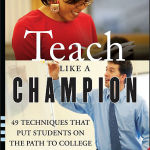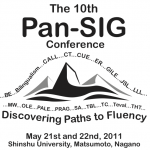Amazon.com curriculum EFL eikaiwa ES expectations JHS kids reviews teaching The Book Depository theory university
by sendaiben
5 comments
Teach Like a Champion in Japan
Teach Like a Champion is a recent book by Doug Lemov. Despite the cheesy title, I found it interesting, inspiring, and useful, and heartily recommend it to any teacher facing classes (the techniques are probably less useful for teaching one on one).
The book was written from a US K-12 (kindergarten to twelfth grade) perspective, so is a perfect fit for teachers working in elementary or junior high schools. Not all of the techniques are suitable for high school or university students, but a lot of them are, particularly in Japan, so even teachers working at those levels should consider it.
Teach Like a Champion is based on a philosophy of efficiency (what works best for the most students in the least amount of time). It’s a mindset that I admire and have been trying to apply to my classes here for quite some time now. One of my favourite parts of the book is where Lemov talks about the opportunity cost of activities:
“(reading) is a high-quality activity (when done efficiently) that can be carried out in any classroom, at any time, and with limited additional preparation or expense required. You can always invest any stretch of time, short or long, in meaningful reading and reap a strong and predictable retun. Furthermore, if you know you could always be doing meaningful reading -in any class, at any time -you can examine your other investments of time critically: do they exceed the value of meaningful reading? Are they potentially higher return but riskier and therefore should be balanced with something more reliable? As you ask these questions, you may well find that reading crowds out some of the other ways you invest your time.”
This mindset permeates the book, and makes it very persuasive. The idea of the opportunity cost of classroom activities is a simple one that I had never really thought about specifically. On reflection, my benchmark activity teaching English in Japan is extensive reading. Now, for me to do something else in class requires that it be more profitable than ER. Using this idea makes a huge difference to lesson planning.
I really like how Lemov brings a critical eye to classroom practice, making the overall tone of the book one of experimentation. The bulk of the book, however, is taken up by 49 very specific teaching techniques. Lemov claims that after observing hundreds of masterful teachers, he found that many of them were using the same strategies and activities, which he describes in Teach Like a Champion. There is also an online supplement with videos of the teachers in question using the techniques. In my opinion it is worth buying the book just to get access to this resource.
Teach Like a Champion is not perfect. It can feel a little cultish at times (all the techniques have names, which Lemov explains as being necessary in order to clearly convey what he is talking about, but names like “at bat” or “pepper” sometimes feel a bit silly), and the focus is very much on the US K-12 system. However, most of the techniques are universal, and I have successfully implemented them with both small group eikaiwa kids and university classes. All things considered, Teach Like a Champion is one of the best books on teaching I have read (I’ve actually read it twice, and am about to re-read it again to refresh everything), and a couple of friends who have also read it feel the same way.
Unfortunately it doesn’t seem to be available through Amazon.co.jp, so I ended up buying the Kindle version from Amazon.com and reading it on my iPhone, but it’s worth getting a copy sent from the US. For a free postage and packing option, check out The Book Depository.
* Disclaimer: the links in this review are affiliate links. If you click on the links and then buy the product, Amazon or The Book Depository will pay me about 3% of the cover price. This comes out of their profits, it does not make the product more expensive for you than buying it normally. Think of it as a tip to this blog. Of course, if you prefer, you can go straight to their websites and search for the book yourself. I won’t hold it against you 😉
conference curriculum EFL eikaiwa extensive listening JALT Language learning presentations readers Reading teaching technology testing
by sendaiben
leave a comment
My favourite conference in Japan
The call for papers for my favourite conference in Japan just came out -you can see more here.
The 2011 JALT Pan-SIG Conference will be held in May in Nagano. I really recommend it. Smaller, more relaxed, and friendlier than the national conference, the real selling point is the distilled value.
The Pan-SIG is made up of all the special interest groups in JALT, groups that specialize in things like computer assisted language learning, extensive reading, teacher training, pragmatics, teaching adult learners, and many others. These specialised groups then choose the presenters they want to represent them. In practice this means that the quality of presentations tends to be very high. I seldom feel I am wasting my time at the Pan-SIG.
I will hopefully be presenting on extensive reading (that idea that Eleanor told me to develop). I hope to see a lot of friends there too!
conference curriculum EFL eikaiwa ES Jelly and Bean JHS kids language courses Language learning readers Reading teaching
by sendaiben
leave a comment
Phonics Readers for Children
My final presentation was on teaching children (and beginners) how to read. Starting with phonics and moving on to phonics readers. I also introduced my favourite reader series, Jelly and Bean (now renamed Follifoot Farm).
conference curriculum EFL eikaiwa language courses presentations readers Reading teaching university
by sendaiben
5 comments
Tweaking Extensive Reading
Here is my presentation from the Extensive Reading SIG Forum at JALT 2010. It was a five-minute description of a seemingly cosmetic change I made to my ER class that resulted in hugely improved results. I encouraged everyone to play with how they ran their programs, as the next breakthrough could be just around the corner.
Got some great advice from Eleanor K. who suggested a topic for me to present at the pan-SIG conference next year.
Thanks Eleanor, I’ll be taking that idea and running with it!
Tired but happy (JALT 2010)
 Just got back from Nagoya and an exhausting but satisfying JALT 2010. Presented three times, got very stressed, learned a lot, met even more great people and managed to spend time with ones I already knew, and got a huge amount out of the conference. Thanks to everyone I saw and hope to see you all again soon.
Just got back from Nagoya and an exhausting but satisfying JALT 2010. Presented three times, got very stressed, learned a lot, met even more great people and managed to spend time with ones I already knew, and got a huge amount out of the conference. Thanks to everyone I saw and hope to see you all again soon.
I’ll be posting my presentations here in the next couple of days, but right now I need some sleep!



